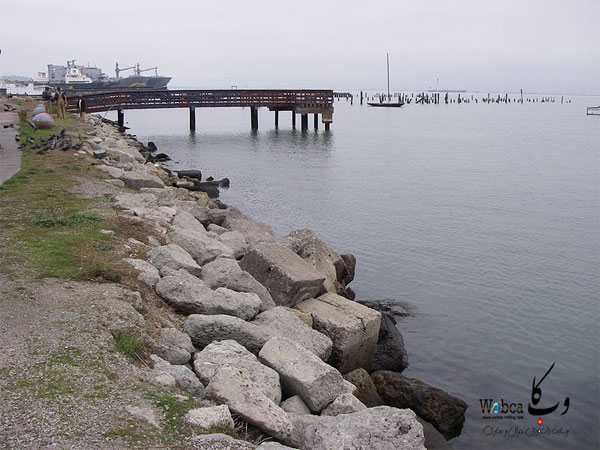در حالت کلی وقتی تراس بندی یا خاکبرداری انجام میدیم یه شیبی به وجود که خاک های اون شیب مستعد آبشستگی و ... هستند ، برای جلوگیری از شسته شدن خاک دو روش داریم:
rip rap یا stone pitching .
که تو rip rap ما میایم از مصالح سنگی و یا مصالح مورد نظر به صورت خشک استفاده میکنیم . ( مثه موج شکن ها )

ولی در Stone pitching قبل یا بعد از اینکه سنگ ها رو ریختیم ، ملات میریزیم تا مصالح بهم بچسبن.

-----------------------------------------------------------------------------------------------------------------------------------
Riprap
Riprap—also known as rip rap, rubble, shot rock, rock armour or Rip-rap—is rock or other material used to armor shorelines, streambeds, bridge abutments, pilings and other shoreline structures against scour, water or ice erosion.
It is made from a variety of rock types, commonly granite or limestone, and occasionally concrete rubble from building and paving demolition. It can be used on any waterway or water containment where there is potential for water erosion.

Protection mechanism
Riprap works by absorbing and deflecting the energy of waves before they reach the defended structure. The size and mass of the riprap material absorbs the impact energy of waves, while the gaps between the rocks trap and slow the flow of water, lessening its ability to erode soil or structures on the coast. The mass of riprap also provides protection against impact damage by ice or debris, which is particularly desirable for bridge supports and pilings.
It is frequently used to protect the base of old Edwardian and Victorian sea walls, which being vertical are often undermined. The riprap absorbs the impact of the waves as they shoot up the wall and then fall back down.
-----------------------------------------------------------------------------------------
Stone pitching
What is it?
A hard-wearing stone surface using large stones, set into the ground in the manner of rough cobbles, to provide a reasonably level surface. From a bird's eye view, looking down on to stone pitching, it looks like the side of a dry stone wall
.

At Oatridge College, stone pitching has been used to sustain a path surface that would otherwise be washed out by floodwater from the nearby watercourse. In this case, stone pitching provides a sustainable surface that can withstand water flowing over the top.

Stone pitching can provide a number of benefits as a path surface:
- A very durable surface on steep slopes or level ground where other path surface types are impractical.
- A solid and immoveable surface that will withstand the most extreme pressures of use and water flow.
- A path surface with a long life expectancy and minimum maintenance requirements.
- A surface that blends in well with the surrounding landscape.
وبكا
Is it suitable?
Stone pitching may not be suitable for all lowland locations and can be unsuitable for some path users. Its rough and uneven surface can be difficult to negotiate, particularly if you are in a wheelchair. Stone pitching requires a source of suitable, preferably hard-wearing, stone available on site which may not be the case for some lowland sites. If stone has to be found and brought onto site, it can make stone pitching a very expensive choice.
How much will it cost?
Stone pitching may cost between £100 - £250 per square metre (labour costs only). The cost of the stone will depend on whether it is already available on site, or whether it needs purchasing and transporting to site.
How do you install it?
For detailed information about how to construct stone pitched paths on steep slopes check out Pitching.
Here at Oatridge College, where the ground is more level, the method of construction was:
Stone pitching may not be suitable for all lowland locations and can be unsuitable for some path users. Its rough and uneven surface can be difficult to negotiate, particularly if you are in a wheelchair. Stone pitching requires a source of suitable, preferably hard-wearing, stone available on site which may not be the case for some lowland sites. If stone has to be found and brought onto site, it can make stone pitching a very expensive choice.
How much will it cost?
Stone pitching may cost between £100 - £250 per square metre (labour costs only). The cost of the stone will depend on whether it is already available on site, or whether it needs purchasing and transporting to site.
How do you install it?
For detailed information about how to construct stone pitched paths on steep slopes check out Pitching.
Here at Oatridge College, where the ground is more level, the method of construction was:
- A machine operator, using a tracked excavator, excavated a formation tray along the line of the path to the required width and depth. A 1.5m wide tray was dug to take large stones and the finished path surface. The tray was dug deep enough to take the largest stone size available.
- The machine operator used the tracked excavator to lift into place large stones that were set flush with the existing ground levels along each side of the tray. These large stones were dug in deep, side by side, to form strong path edges that are solid and immovable.
- Once all the large stones were installed, starting from both ends of the tray and working towards the centre, path workers placed large pitching stones lengthways into the tray in rough rows across the tray width, between the two edge rows. All stone was butted tightly together against adjoining stones, on all side faces. All gaps between stones were wedged firmly with small stones, before the next row of stone was pitched. This ensures that the pitched stone was solid and would not be dislodged when the next row of stone was laid. Joints on adjoining rows of pitched stone were overlapped to give a solid and immoveable structure.
- Once all stone pitching was completed, the path workers infilled and compacted all gaps between pitched stones with smaller stones. This sealed the joints, preventing water getting in and under the pitching, as this would eventually loosen, wash out, or break up the stone when the water freezes and expands in cold winter temperatures.
- That was the stone pitching done, but work had not quite finished yet! Path edge finishing work was still needed to blend the pitched path into its surroundings. The path workers, using available turfs and excavated spoil from the tray, landscaped the edges to ensure all the side faces of the edge stones were covered. The line of the path was defined and the appearance of the stone surface 'softened'. Landscaping work is an important element of path construction work – it can help to soften the path's appearance in the landscape


 پایان نامه کمپ ورزشی , کمپ تمرینی شهر فوتبال + اتوکد و تریدی
پایان نامه کمپ ورزشی , کمپ تمرینی شهر فوتبال + اتوکد و تریدی 
